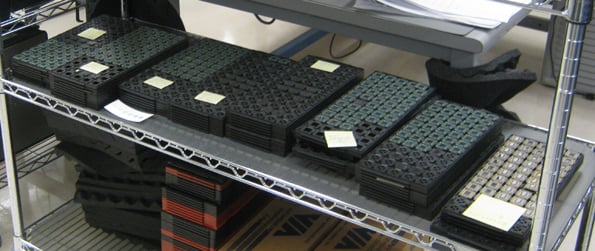VIA Launches New Low Power QuadCore Nano CPU
Via's New Quad-Core
The dual-module chips are the quad-core, the single dies are the Nano X2.
VIA's share of the x86 market is small in comparison to Intel and AMD, but Centaur, the company's CPU design team, has been building x86 CPUs for more than a decade. Centaur, led by the redoubtable Glenn Henry, has always focused on extremely efficient, low-power processors. When Via claims that Intel and AMD are following the path it started blazing in 2000, it has something of a point. Via's original Nano (codenamed Isaiah) processor, which launched in 2008, was the company's first out-of-order execution chip. Reviews proved that the processor could genuinely compete with Intel's Atom, but only two companies, Samsung and Lenovo, brought Nano-powered netbooks to the US market.
Over the last three years, Via refined the original Isaiah core, significantly improving its performance. The new QuadCore Nano is the most powerful processor Via's ever built, but it retains the same focus on efficiency that's been a hallmark of all of Centaur's architectures.
The Chip

Centaur has also baked in its own performance-enhancing mode dubbed 'Adaptive Overclocking.' Despite the name, it doesn't void the CPU's warranty. It's VIA's answer to Intel's Turbo Boost or AMD's Turbo Core; products with this feature are labeled with a plus sign. The QuadCore 1.2GHz+, for example, will run at up to 1.46GHz depending on the CPU's temperature, power consumption, and the number of cores currently in use. If the chip becomes too hot, the system automatically drops back to 1.2GHz. When the chip is idle, Via's own power conservation modes kick in, further reducing clockspeeds and voltages.
Performance and Power Consumption
At 27.5 watts, the QC Nano's rated TDP is significantly higher than AMD's Brazos chips (which are rated at 9-18W) or Intel's Atom (12-14W). That knocks the new quad-core chip out of the netbook/ultra-mobile market, but low-end notebooks often use parts with similar TDPs. Performance is equally important here—quad-core hardware is only attractive if the extra two processors offer a more compelling experience. We weren't allowed to run independent benchmarks; Via pitted one of their 1.2+ QuadCore's against an AMD Brazos E-350 (1.6GHz). Both systems used 2GB of RAM and ran Windows 7.

Trays of CPUs undergoing validation. The green chips are 3000-series Nano processors.
Results were mixed. The Nano was twice as fast as the E-350 in Cinebench R10, despite the Bobcat's 400MHz speed advantage, but Bapco's Sysmark 2007 showed Via beating AMD by a slim five percent. Synthetic tests tended to favor Via, GPU tests like 3DMark 06 swung back towards AMD. The two system's were neck-and-neck overall—Via won 3DMK6 by five percent—despite the fact that it was more than twice as fast as Brazos in the benchmark's CPU test. When it came to transcoding, Via won by 12 percent.
The QuadCore may have been fighting with one hand behind its back, however. According to VIA, the QuadCore test system used a 1066MHz FSB instead of 1333MHz, and relied on VIA's older Chrome 9HD integrated GPU instead of the Chrome 520 that normally ships with the VN1000, which will be the chipset / launch platform that will accompany the Quad-Core. Via's results imply (we stress that for a reason) that the 1.2GHz+ QuadCore Nano is 10-15 percent faster than Brazos, just as Brazos is 10-20 percent faster than Intel's 1.8GHz dual-core Atom.

Note that these are rated TDPs, not measured values. Also, AMD measures TDP differently than Via, who uses the same definition Intel does.
Via claims its L4700 is the lowest-power quad-core on the market, but its graph is an inadvertent reminder that quad-core Llano is coming soon. If AMD's new mainstream part performs well, it could significantly challenge Via's quad-core Nano. Indeed, Llano will launch first; AMD's APU is reportedly launching 'very soon', while VIA doesn't expect the new Nano to arrive before Q3. On the other hand, VIA's manufacturing costs are extremely low; QuadCore Nano could potentially carve itself a niche by undercutting Llano--or even Brazos.
Will Anyone Be Able To Buy It?
Via has had a very difficult time creating momentum around Nano. The problem dates back to the CPU's launch in 2008. HP based their Mini-Note on VIA's C7 and reportedly had plans to use Via's Nano in the next iteration of the product. For whatever reason, that didn't happen, and Nano-based products are few and far between in the U.S. The company hopes that the new focus on mobile devices and low-power computing will help the QuadCore and Nano X2 both gain traction—particularly with users who like thin-and-light systems but want a device that provides more oomph than a single or dual-core Atom.
With any luck, the situation will start to turn around once the new QuadCore chip begins shipping in volume. When all is said and done, the Nano has always been a more competitive solution than its sales figures imply. Centaur is already working on its next-generation part; the next CPU will debut on 28nm, will sport an overhauled, improved core architecture, and will incorporate other functions--a vague phrase we'd bet includes an integrated memory controller—or even a GPU.






